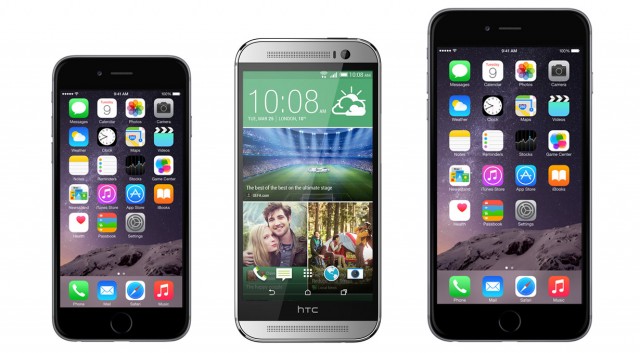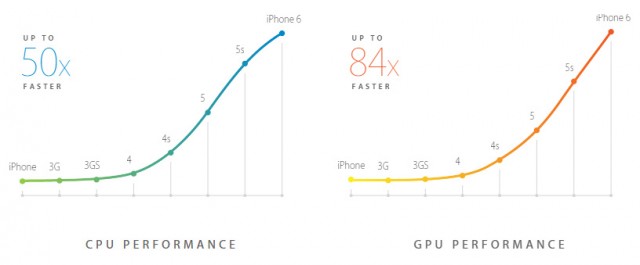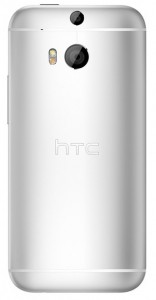
iPhone 6 vs. iPhone 6 Plus vs. HTC One M8 compared: Which one should you buy?
Yesterday, Apple announced the iPhone 6 and iPhone 6 Plus — and, rather amusingly for a company that has always extolled the virtues of smaller screens (and mocked the larger screens of Android devices), both of the new models have large screens. In the past, it never seemed entirely fair to compare the specs of the iPhone 4 or 5 against larger Android devices — but now, with Apple officially joining the battle for a market that is quickly gravitating towards large-screen devices, it’s time to compare the 4.7-inch iPhone 6 and 5.5-inch iPhone 6 Plus against the best the Android market can muster: The HTC One M8. We’ll also talk about where the Samsung Galaxy S5 and Note 3/4 fit into the equation.
For this comparison we’ll mostly be focusing on hardware specs and advertised software features. As the iPhone 6 and 6 Plus aren’t yet available, some comparisons won’t be 100% accurate — but we’ll try to update this post after Apple’s new smartphones are officially released.
Display: iPhone 6 vs. iPhone 6 Plus vs. HTC One M8
Let’s start with the most obvious change between the iPhone 5S and both of the new iPhone 6 models: Screen size and resolution. While the iPhone 6 has a 4.7-inch display, its resolution is relatively low at 1334×750 — the same 326 PPI as the iPhone 5S. The 5.5-inch iPhone 6 Plus steps up to a full 1920×1080 display, or 401 PPI. The HTC One M8 has a 5-inch panel at 1920×1080, or 441 PPI.
For the iPhone 6 and iPhone 6 Plus, Apple has apparently updated its Retina display to… Retina HD. Retina HD apparently delivers higher contrast and more accurate color reproduction. Early hands-on reviews say that both new iPhones have fantastic displays, but we’ll have to wait for some objective comparisons. The One M8′s display is one of the best out there.
The iPhone 6 and 6 Plus use IPS panels, while the HTC One M8 uses Super LCD (SLCD). Functionally, this should make very little difference. Both technologies have good viewing angles, contrast, color gamut, and so on.
In terms of pure pixel density, the HTC One M8 probably has the better display. The iPhone 6′s 1334×750 resolution is a little bit disappointing, but Apple had to maintain a specification gap between it and the iPhone 6 Plus. In any case, though, all three phones should look fantastic.
Size and weight: iPhone 6 vs. iPhone 6 Plus vs. HTC One M8
With apologies to a famous comic book movie: With a greater display comes greater size and weight.
iPhone 6: 138.1mm long, 67mm wide, 6.9mm thick. 129 grams (4.55 oz).
iPhone 6 Plus: 158.1mm long, 77.8mm wide, 7.1mm thick. 172 grams (6.07 oz).
HTC One M8: 146.4mm long, 70.6mm wide, 9.4mm thick. 160 grams (5.64 oz).
As you’d expect with its 5-inch screen, the One M8 sits almost perfectly between the two new iPhones. There is no denying that the iPhone 6 and iPhone 6 Plus are both incredibly thin, however — and according to hands-on impressions, it is this thinness that makes the iPhone 6 and 6 Plus easier to hold and manipulate than the HTC One M8.
The Samsung Galaxy S5, in case you were wondering, is 145 grams and 8.1mm thick — so, significantly thinner than the One M8, but still a long way off the new iPhones. The Galaxy Note 4 is very similar to the iPhone 6 Plus in terms of dimensions and weight, but it packs in a larger and much-higher-res screen (5.7 inches @ 2560×1440).
Hardware specs: iPhone 6 vs. iPhone 6 Plus vs. HTC One M8
It’s always a little complex (and not really very objective) to compare the internals of Apple and Android devices. Apple usually goes for lower clock speeds (to save power), and smaller amounts of RAM (to cut costs and some power), but no one would say that the iPhone 6 or iPhone 6 Plus is a slow or sluggish phone.
So far, all we really know is that the iPhone 6 and 6 Plus have the new 20nm Apple A8 SoC. We’ll be analyzing this chip in further depth later today. For now, it looks like it’s an updated version of the dual-core A7 SoC, but with a larger GPU. You will not be disappointed by the A8′s performance, I can tell you that much. It also looks like there’s just 1GB of RAM in the iPhone 6 and 6 Plus, but that’s unconfirmed. There is an updated M8 “motion coprocessor” in the iPhone 6 and 6 Plus, too, which presumably reduces sensor power consumption — but I’m sure the HTC One M8 has some coprocessors as well (they’re just not marketed as such).
The HTC One M8 has the Snapdragon 801 SoC, which has a strong quad-core Krait CPU, but the Adreno 330 GPU is fairly dated by this point. The Galaxy Note 4, Note Edge, LG G3, and updated Galaxy S5 LTE-A (Korea only) have the newer Snapdragon 805 with Adreno 420 GPU, which will probably fare better against Apple’s A8 SoC. There is 2GB of RAM in the HTC One M8.
Interestingly, the iPhone 6 and iPhone 6 Plus now come in 16GB, 64GB, and 128GB models. The HTC One M8 only comes in 16 or 32GB flavors — but it has a micro SD card slot, unlike the iPhones. The iPhone models both come with the Touch ID fingerprint sensor, while the One M8 does not. (The Galaxy S5 does have a fingerprint sensor, but it’s a bit shoddy.)
Battery life: iPhone 6 vs. iPhone 6 Plus vs. HTC One M8
There’s no word on the actual size (watt-hours, mAh) of the iPhone 6 or iPhone 6 Plus battery, but Apple is promising some impressive battery life figures nonetheless. The larger chassis of the iPhone 6 and 6 Plus hopefully allowed Apple to squeeze in a significantly larger battery over the iPhone 5S. On the iPhone 6 — according to Apple’s own figures — you should get 11 hours of web browsing over WiFi, 10 hours over LTE, and 11 hours of video playback. The iPhone 6 Plus steps up to 12 hours over WiFi and LTE, and 14 hours of video playback.
The HTC One M8 has a fairly small battery as far as big Android phones go (2,600 mAh), and HTC doesn’t provide official surfing/video playback battery life figures. The Galaxy S5 (with a big, replaceable 2,800 mAh battery) is better in this regard. In any case, the One M8 is usually good for a full day of mixed usage — but you will probably get better battery life from the iPhone 6, and certainly the iPhone 6 Plus. We need to do some real testing before these figures can be confirmed, though.
Cellular and wireless connectivity: iPhone 6 vs. iPhone 6 Plus vs. HTC One M8
As you’d expect, the iPhone 6 and iPhone 6 Plus (especially the GSM versions), and HTC One M8, have very broad support for most of the world’s cellular and wireless connectivity standards. All three phones have support for 802.11ac, Bluetooth 4.0, and NFC. (Apple’s new Apple Pay platform will probably make the NFC solution in the iPhone 6 and 6 Plus more useful than the One M8, however.)
We can’t be certain at this point, but it seems all three phones use the same Qualcomm MDM9625 modem — so there’s wide support for most 3G and 4G bands, and up to LTE Cat 4 (150Mbps down, 50Mbps up). The iPhone 6 and 6 Plus do seem to support VoLTE, while the HTC One M8 does not. We’ll probably talk more about the iPhone 6′s cellular band support in a future story. In the mean time, if you’re wondering whether the iPhone 6 or 6 Plus will work in your country, check Apple’s tech specs.
Author: By Sebastian Anthony


